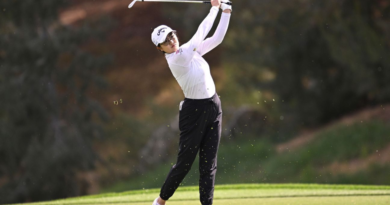Women's Ballon d'Or mess shows soccer has a long way to go
When Spain‘s World Cup winner Aitana Bonmatí strode to the stage to collect her well-deserved Ballon d’Or Féminin award on Monday night, there was a sense of disrespect. And not for the first time.
The moment should have been a celebration of women’s football. But how could it be when the ceremony was scheduled during a women’s international window? Most of the nominees were either unable or not allowed to attend because of Nations League commitments or Olympic qualifiers the following day.
“It’s unfortunate we couldn’t be there,” one of England’s nominees, Georgia Stanway, said Tuesday. “That’s something we spoke as a player group [about], and we just kind of said it would be nice in the future if it wasn’t on a matchday -1, so that we could enjoy the experience.
“It is [frustrating], because it’s potentially a once-in-a-lifetime opportunity. You never know if you’re ever going to get selected for such an accolade like that again, so it would be really nice to enjoy the experience and be there and feel like a star amongst the stars. If it was planned a little bit better, then maybe it would be easier for a lot of female footballers to be there.”
Bonmati was there to represent the women’s game — and she had to leave Spain camp between games and rush back before facing Switzerland in Zurich on Tuesday night — but her Ballon d’Or was placed on stage after she arrived by a stagehand.
– Stream on ESPN+: LaLiga, Bundesliga, more (U.S.)
Another issue was the person designated to present her with the award in Paris: Novak Djokovic, the No. 1 men’s tennis player who has previously spoken out against equal pay in sport and has no link to women’s football.
Why tennis, you ask? Well, if it had been Serena Williams, who has spent her whole life elevating the image of women in sport, or Billie Jean King, who continued her legendary advocacy in women’s sport long beyond the end of her own playing career, it wouldn’t have raised eyebrows. If it had to be a men’s player, how about outspoken feminist Andy Murray? Spanish great Rafael Nadal would have at least been relevant to Bonmati.
The two journalists who invented the Ballon d’Or, Gabriel Hanot and Jacques Ferran, can be forgiven for not including a Ballon d’Or Féminin in the inaugural award (won by Stanley Matthews in 1956), with women’s football still struggling under blanket bans around the world. Indeed, West Germany’s Gerd Müller had only just won it when the France women’s national team played their first official match in 1971.
But while the UEFA Best Women’s Player in Europe Award was created in 2013 (two years after the male equivalent) and the FIFA Women’s World Player of the Year was started in 2001 (the men’s award was 1991) and rebranded at FIFA The Best awards in 2016, progress to integrate the women’s game into the Ballon d’Or has been slow and it took until 2018 for women to be included.
Soccer fans will remember the 2018 ceremony for many reasons. On the men’s side, Luka Modrić finally broke the 10-year stranglehold Cristiano Ronaldo and Lionel Messi had on the award. It was also the first year that the Kopa Trophy, for the best player under 21, was handed out, but only on the men’s side. For those who follow women’s football, the memory of Norway‘s Ada Hegerberg in her gold dress walking down to the podium to accept the inaugural Féminin trophy was there. But it was overshadowed.
Hegerberg might not have been at the top of everyone’s list for the award — the Lyon striker narrowly beat out Pernille Harder — but her parade was swiftly rained on when French DJ Martin Solveig asked if she knew how to twerk. Hegerberg pursed her lips to say “non,” before turning away.
While an outpouring of criticism followed and (ironically) one of the most vocal was a tennis player: Andy Murray. “What questions did they ask Mbappé and Modric?” he wrote on Instagram. “I’d imagine something to do with football. And to everyone who thinks I’m overreacting and it was just a joke … it wasn’t. I’ve been involved in sport my whole life and the level of sexism is unreal.”
The men’s Ballon d’Or ceremony has continued to grow with additional awards added beyond the Kopa Trophy. The Yashin Trophy to celebrate excellence in goalkeeping was added the following year and, two years later, the Gerd Müller trophy (initially named Striker of the Year, no guesses for which position it lauds.) Yet there are still no women’s equivalents. No awards for women goalkeepers, strikers, or those under 21. Just the Ballon d’Or.
When the ceremony returned in 2021, following a COVID-19 enforced gap, it was scheduled during a women’s international window. During the presentations, Netherlands duo Vivianne Miedema and Lieke Martens (who finished fourth and fifth in the voting) were actually part way through a match, while Sam Kerr (who finished third) would have been sleeping ahead of Australia‘s home friendly against the United States. Although the winner, Alexia Putellas, was there to accept the award, she had to hightail it back to Seville for a European qualifier against Scotland the following night — an 8-0 drubbing she started and scored in.
Two years later and nothing has changed.
There will always be debates around individual awards, about how watered down the Ballon d’Or has become, and, especially in women’s football, who is having a say and if they are truly fans of the game or not. But a sport that was condemned to the shadows for so long has seen its moments in the sun repeatedly covered by grey clouds.
The Ballon d’Or has a long way to go. Will next year be any different? If history is any indication, you shouldn’t get your hopes up.




